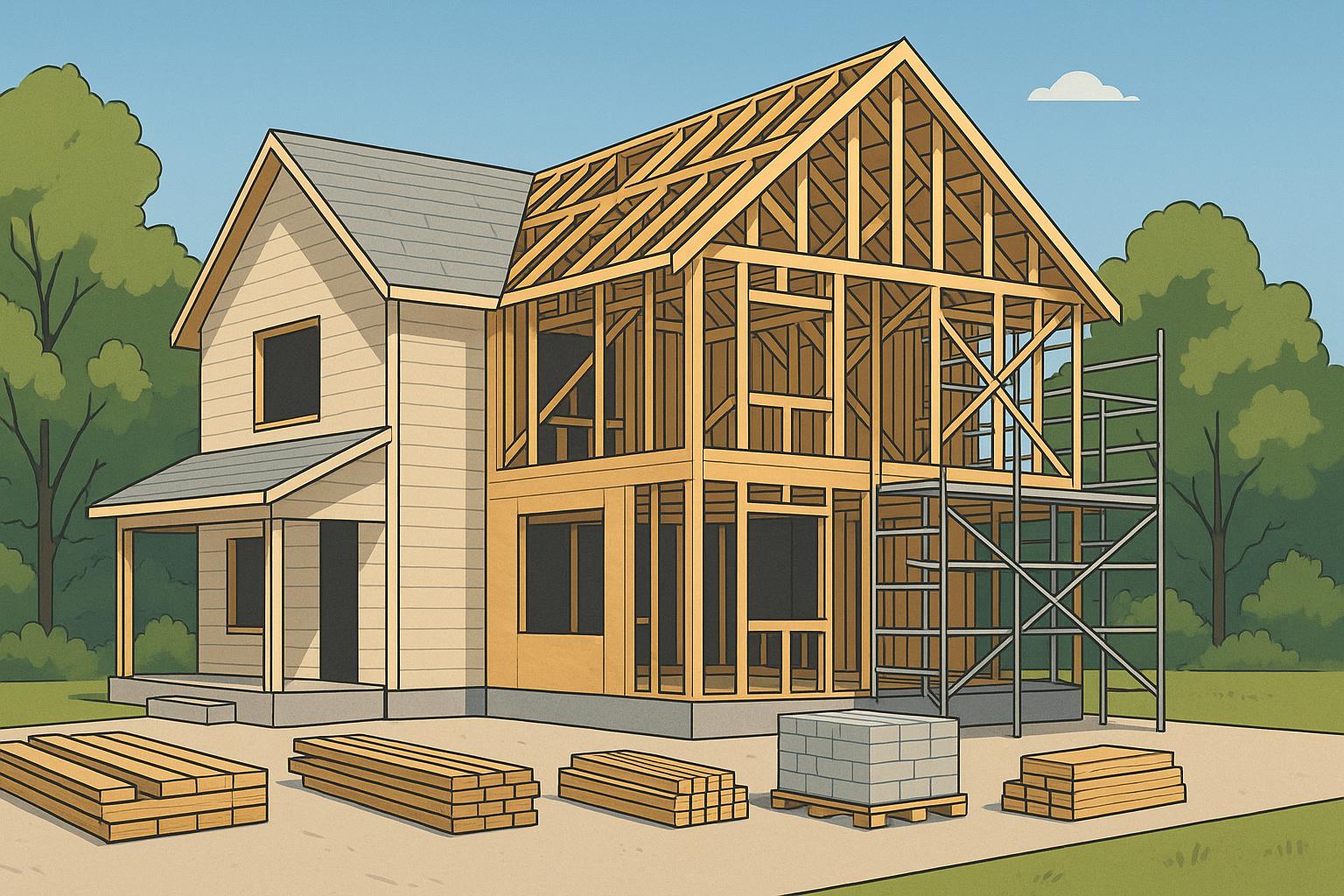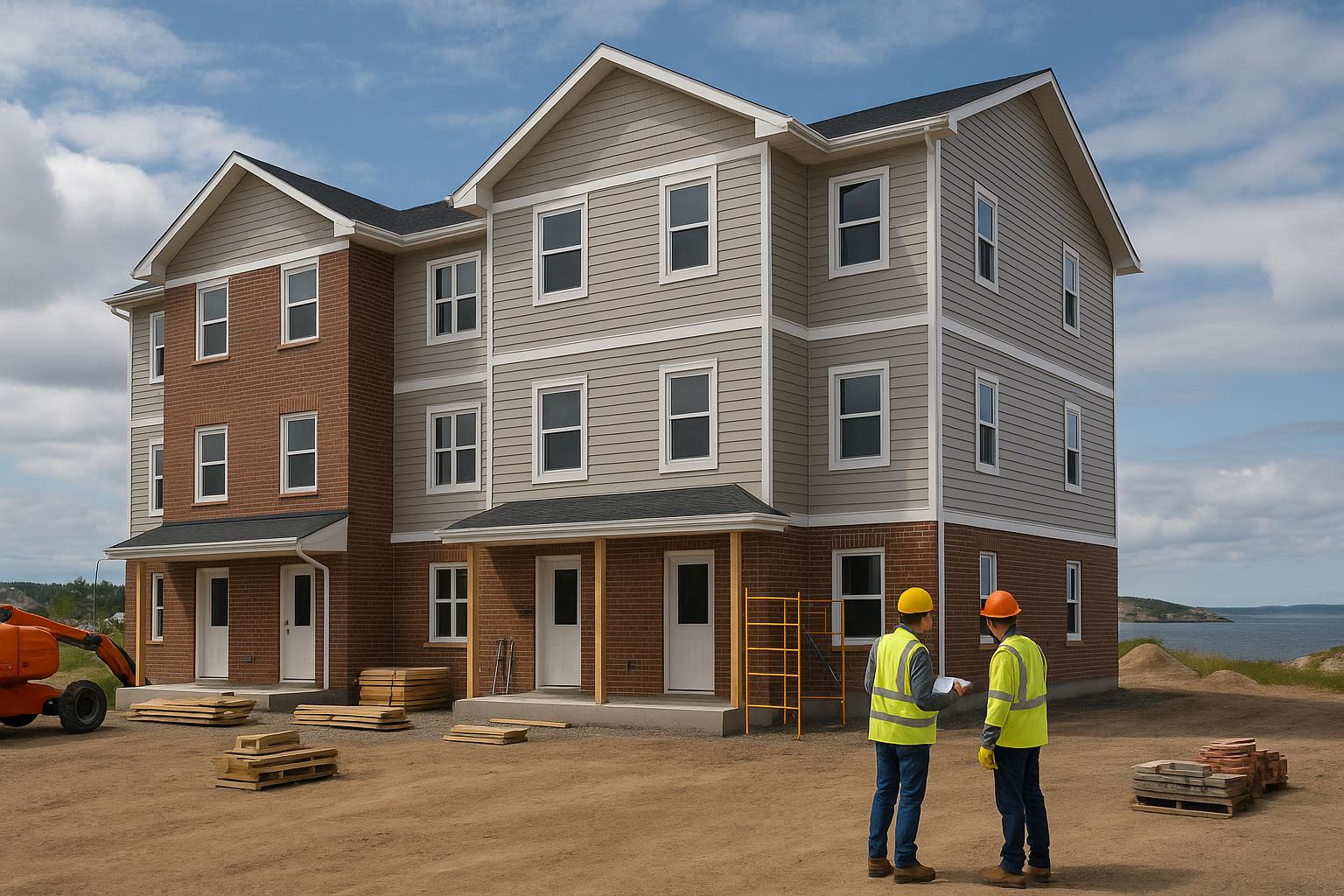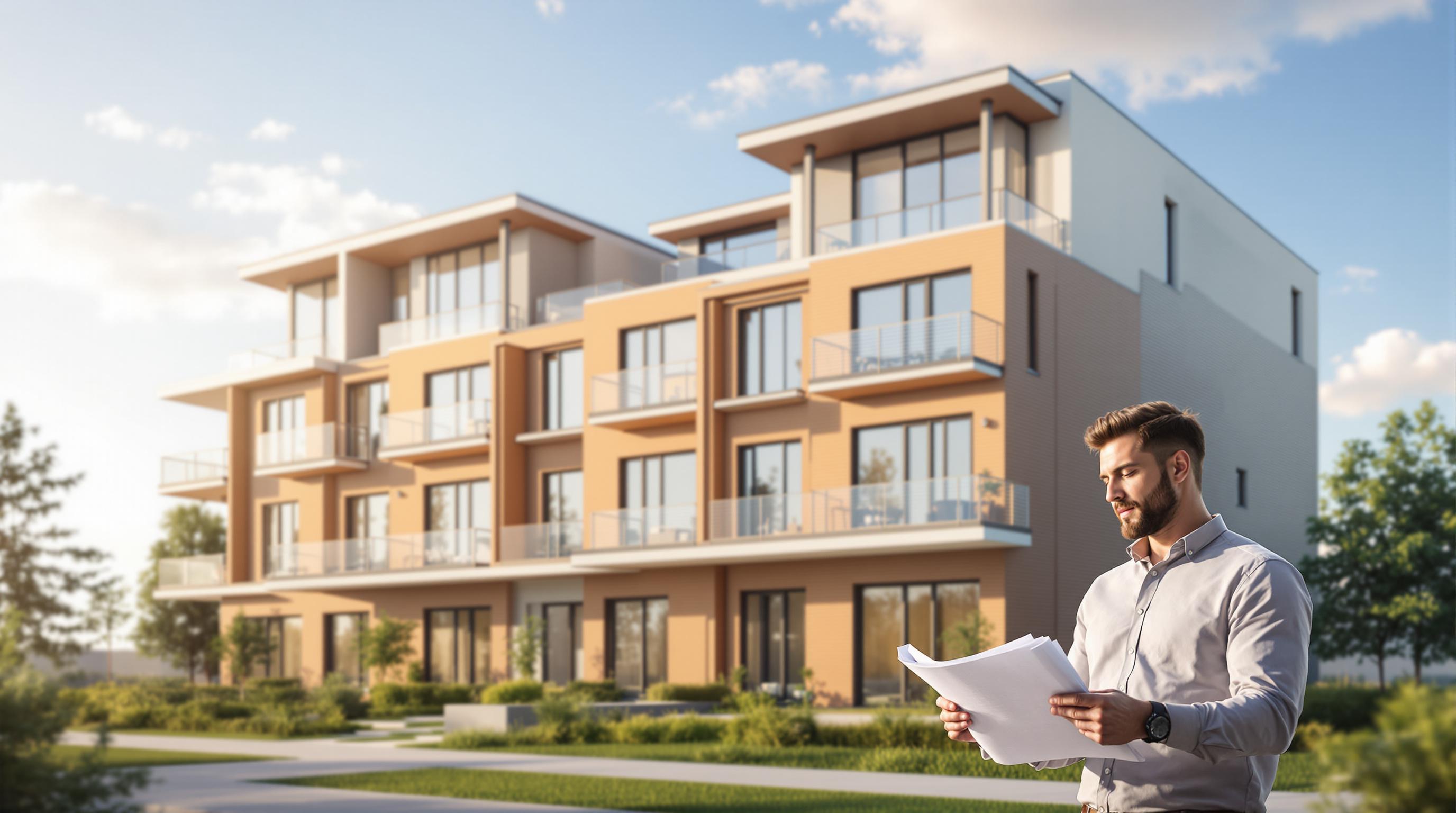Gottingen Street in Halifax is emerging as a hotspot for mixed-use development, combining residential and commercial spaces. Why? The area offers:
- Strong rental demand: Two-bedroom units fetch $1,950–$2,100/month.
- Walkability: A Walk Score of 96/100 attracts city dwellers.
- Commercial potential: Ground-floor spaces benefit from steady pedestrian traffic.
- Favourable zoning: New rules allow higher densities and building heights.
- Cost benchmarks: Standard construction costs $160,000 per unit, while energy-efficient builds cost $200,000 per unit with CMHC financing perks.
Developers can avoid delays and budget overruns by adopting an integrated design-build model, which combines planning and construction under one contract. This approach ensures fixed costs, faster timelines, and better quality control. With demand rising and returns of 12–20% achievable, Gottingen Street is a prime location for those ready to invest.
Build to Rent Mixed-Use Case Study: Breaking Down a 16-Unit Ground Up Development!
Market Analysis: Demand and Opportunities
The Gottingen Street corridor is showing promising potential for mixed-use developments, thanks to its solid market fundamentals. By understanding the trends in both residential and commercial demand, property owners can strategically align their projects with the needs of this rapidly evolving neighbourhood.
Residential Rental Demand on Gottingen Street
Gottingen Street is quickly becoming a lively urban hub, supported by its excellent location and connectivity. With an impressive Walk Score of 96/100 [1], the area is highly attractive to city dwellers who prioritize convenience and accessibility.
Market data shows that well-designed two-bedroom rental units in the area command monthly rents between $1,950 and $2,100. This highlights the increasing draw of the neighbourhood. Additionally, strong transit options and bike-friendly infrastructure help residents save on transportation costs, adding to the appeal of living here.
This high demand for residential units also has a positive ripple effect, enhancing the viability of ground-floor commercial spaces.
Commercial Space Demand in the Gottingen Corridor
The commercial activity along Gottingen Street mirrors the neighbourhood's dynamic and evolving character [2]. Ground-floor commercial spaces in mixed-use buildings thrive on the steady pedestrian traffic, offering residents convenient access to retail and services.
What makes mixed-use developments particularly appealing for businesses is the built-in customer base provided by the residents. This setup often leads to reliable occupancy rates across the property.
Moreover, the area's walkability and excellent transit links extend the reach of commercial spaces beyond the immediate neighbourhood, drawing in customers from other parts of the city. Together, these residential and commercial trends create a strong foundation for exploring zoning and regulatory considerations in the next phase of planning.
Zoning and Regulatory Requirements
Getting familiar with HRM's zoning rules and permit process early on is crucial. Mixed-use projects often require several permits, which can significantly impact your project timeline.
Zoning Considerations
HRM's zoning framework is designed to accommodate mixed-use developments, but understanding the specific regulations is critical. To ensure your project stays on track, consult HRM early to confirm zoning compliance.
Permits and Regulatory Challenges
After confirming zoning compliance, the next step is obtaining the necessary permits. This includes the primary Mixed Use or Commercial Building Permit, along with any additional reviews related to land use and community impact. All permits are issued through the Planning & Development Permit Office. Starting this process early can help mitigate potential delays.
Community involvement is another key element of the application process. HRM usually requires developers to consult with the public for mixed-use projects. This step is an opportunity to address concerns and gather feedback, which can help smooth the path to approval. Engaging with municipal planners early in the process can also simplify approvals and minimize setbacks.
Proactive and early coordination with HRM is essential to navigate these regulatory steps effectively and keep your project moving forward.
sbb-itb-16b8a48
Construction Costs and Delivery Models
Getting a clear picture of construction costs upfront is key for property owners planning mixed-use projects on Gottingen Street. The delivery model you choose can have a big impact on both your budget and how predictable your timeline is.
Cost Benchmarks for Mixed-Use Projects
The cost of mixed-use construction in Halifax depends on the level of quality and energy efficiency you aim for. Standard construction typically costs $160,000 per residential unit when opting for quality builds with premium finishes. This pricing assumes a minimum of four units, so the starting cost for a mixed-use building is $640,000.
If you're looking at CMHC MLI Select financing, you should plan for $200,000 per unit to meet higher energy efficiency standards. These builds are designed to be 40% more energy efficient than the standard building code, which not only helps with sustainability but also unlocks better financing terms. With this model, property owners can access 95% financing with just a 5% down payment. While the upfront costs are higher, the improved financing terms and cash flow often make it worth the investment.
Investing in energy efficiency upgrades also makes sense financially for properties on Gottingen Street. Two-bedroom units in well-constructed, energy-efficient buildings can command rents of $1,950–2,100 per month. Tenants are often willing to pay more for these benefits, making energy-efficient construction a smart choice for attracting premium renters.
Integrated Design-Build vs Fragmented Construction
Choosing the right construction delivery model is essential for keeping costs under control and meeting your timeline. Many property owners struggle with the traditional, fragmented approach to construction. This method requires managing separate architects, engineers, contractors, and trades, which often leads to inefficiencies. These inefficiencies can add 30–60% to your budget and stretch an 8-month project to 18 months or more.
Switching to an integrated design-build model can solve these problems. This approach brings all construction professionals together under one company, so property owners only need to manage a single contract. From planning to final construction, the entire process is streamlined for efficiency.
| Fragmented Construction | Integrated Design-Build |
|---|---|
| Multiple contracts to manage | Single contract accountability |
| Cost-plus pricing with overruns | Fixed-price construction |
| 12–18 month typical timeline | 6‑month guaranteed completion |
| Finger-pointing between trades | One company responsibility |
| Hope-for-the-best approach | Systematic delivery process |
Budget certainty is a major advantage of the design-build model. Fragmented construction often leads to overruns that can average $47,000 per project, while fixed-price contracts lock in costs to avoid surprises.
Timelines are another critical factor. Delays in construction can mean missed opportunities to lease units. Some integrated builders even offer penalty clauses - up to $1,000 per day for delays - giving property owners extra peace of mind.
The quality assurance process also sets these two approaches apart. Fragmented construction often relies solely on municipal inspections, while the design-build model includes regular inspections by professional engineers and offers comprehensive warranties.
For property owners on Gottingen Street, the integrated design-build model also provides daily transparency. With photo updates and real-time monitoring, owners stay informed throughout the project, reducing the risk of unexpected issues that can derail traditional construction methods.
Design-Build Strategies for Gottingen Street Success
Gottingen Street's mixed-use developments thrive when design-build strategies are seamlessly integrated. These strategies not only address the challenges of combining residential and commercial spaces but also enhance the overall functionality and appeal of properties in Halifax’s bustling urban core.
Planning for Mixed-Use Efficiency
The foundation of any successful mixed-use project lies in meticulous planning. When architects, engineers, planners, and construction teams collaborate as one cohesive unit, they can create designs that maximize rental potential while ensuring smooth operations. For instance, a thoughtfully designed ground floor can attract high-quality commercial tenants, while the upper residential floors continue to provide comfortable and flexible living spaces.
Careful planning of building systems and utilities is essential to avoid unexpected costs during construction. By designing utility systems with clear distinctions - such as separate access points or dedicated setups for residential and commercial areas - property management becomes much simpler. These deliberate design choices not only save money but also contribute to the efficient operation of the entire building.
Lessons from Halifax Mixed-Use Projects
Halifax's experience with mixed-use developments offers valuable takeaways. The integrated design-build approach has consistently delivered predictable timelines and controlled budgets. This ensures that tenants can move in on time, all while keeping the project financially on track.
Quality control is another critical factor. By implementing multiple inspection phases during construction, developers can ensure both residential and commercial spaces meet high standards. This proactive approach reduces the likelihood of costly repairs or complaints after occupancy.
Energy efficiency has emerged as a key consideration in Halifax's market. Recent projects show that energy-efficient designs not only appeal to eco-conscious tenants but also lead to reduced operating costs for commercial spaces, making them more attractive to businesses.
Finally, a unified warranty program simplifies post-construction maintenance. Developers who follow a systematic, integrated process are better equipped to deliver high-quality results from the outset, while also maintaining schedules and budgets. This approach ensures that both property owners and tenants benefit from a well-executed project.
Conclusion: Gottingen Street Mixed-Use Potential
Gottingen Street stands out as a prime location for mixed-use development within Halifax's urban core. With strong demand for residential rentals and increasing commercial interest, this corridor offers the right ingredients for projects that effectively combine both elements.
The key to success lies in understanding local demand, navigating zoning regulations, and adopting a streamlined design-build approach. Traditional construction methods often lead to delays and budget overruns, but an integrated design-build process keeps everything on track. By uniting planning, design, and construction teams from the start, this method ensures predictable costs, clear timelines, and reduced risks - especially important for mixed-use projects where residential and commercial components must work seamlessly together.
The numbers back up the potential. Quality two-bedroom residential units in this area are renting for $1,950–$2,100 per month, while commercial spaces are commanding premium rates thanks to the area's ongoing revitalization. These factors make annual returns of 12–20% a realistic goal for well-executed developments.
By choosing an integrated design-build approach, developers can transform what might seem like a high-risk venture into a reliable and profitable investment. This method delivers fixed prices, dependable schedules, and peace of mind.
For those ready to explore Gottingen Street's promise, Helio Urban Development is here to help. As Nova Scotia’s leader in integrated design-build services, Helio currently has 31 units under construction and 131 more in the planning stages across Halifax. Their expertise ensures a smooth process and strong returns.
Reach out to Helio Urban Development to discuss your Gottingen Street project and see how their approach can deliver the predictable, profitable results your investment deserves.
FAQs
What are the advantages of using an integrated design-build model for mixed-use projects on Gottingen Street?
An integrated design-build approach brings a host of benefits for mixed-use projects on Gottingen Street. By uniting the design and construction processes under one team, this method promotes seamless communication, cuts down on delays, and avoids expensive missteps. The result? Projects move forward faster with better coordination.
Another key advantage is risk reduction. Early collaboration among all stakeholders helps keep costs in check and minimizes unexpected changes along the way. This creates a more predictable and efficient process, offering property owners greater confidence and control over their investment.
What impact do Halifax's zoning rules and permit processes have on the timeline and feasibility of mixed-use developments?
Halifax's zoning rules, particularly the COR zoning outlined in the Centre Plan, are designed to encourage mixed-use developments. The focus is on creating higher-density, walkable communities in key areas of the city. While this approach supports urban growth and vibrancy, it often involves a site plan review, which can add time to the approval process. Depending on the project, especially for multi-unit developments, permits could be approved in as little as six months - assuming everything moves smoothly.
That said, these regulations can make project planning more complex. Getting a clear understanding of zoning and permit requirements early in the process can make a big difference. It helps keep things on track, ensures your project meets all the criteria, and reduces the risk of unexpected delays.
What makes Gottingen Street a strong location for mixed-use developments, and how can property owners take advantage of this opportunity?
Gottingen Street stands out as an ideal location for mixed-use developments, thanks to Halifax's expanding population and thriving economy. With ER-3 zoning in place, the area is well-suited for small-scale apartment buildings. Its ongoing revitalization has further boosted its appeal, making it a magnet for both residents and businesses. This combination drives strong rental demand and promising commercial opportunities.
For property owners, this is a chance to design projects that blend affordable rental housing with commercial spaces tailored to the community's needs. Leveraging the zoning flexibility and Halifax's economic growth, these developments can strike a balance between profitability and long-term viability.



